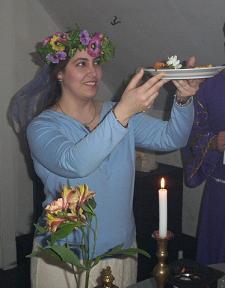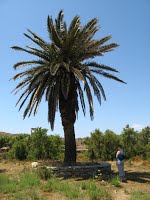by Melissa
(16th Mounykhion) The month of Mounykhion is named after the festival of Artemis of Mounykhia, the name of a steep hill, Mounykhia (itself named for the hero Mounykhos), which is near the Athenian port, Peiraios. Here, Artemis, always at home on mountain slopes, had a sanctuary. This holiday probably became more important when Athens established its naval base at Peiraios in 429BCE.
Two types of offerings are associated with this festival, which seem to point to two different sides of Artemis’s character: This festival honors Artemis as Lady of the Beasts, Potnia theron, and as Moon Goddess. In the first case, a she-goat dressed as a girl was sacrificed. This was to commemorate what happened when the Athenians slew a she-bear that had entered Artemis’s shrine. When Artemis became angered by the Athenians’ actions, the Oracle declared that someone must sacrifice his daughter to Artemis. Finally one man agreed to do so, but performed a switch at the sanctuary, offering the goat dressed as a girl instead. In return, the man acquired the priesthood of the goddess for life (Parke 136-7)

The second type of offering connects her to the moon, which is full at the time of this festival. Round cakes called amphiphontes (“shining all around”), in which dadia (little torches) were stuck, were brought to her by a procession on the night of the 16th. “They had lighted candles stuck in a circle,” writes Parke, “and ancient commentators were probably right in seeing in this some reference to the circle of the moon” (p 138). The name amphiphon can also mean “Shining by Double Light,” possibly because the cake was offered when the sun and moon are both visible. In The Girl from Rhodes, Philemon has the cakes offered to the Artemis with this prayer:
“Artemis, Dear Mistress, to Thee I carry, Lady, this Amphiphon, and what shall serve as drink offering.”
In Hellenistic times, the festival became a general festival in the port of Peiraios, ending with a boat race by the ephebes, young men in military training, from the harbor of Peiraios to the harbor of Mounykhia (Parke 138-9).

Another Artemis cult also involves a bear, this time at Brauronia, near the east coast of Attica. Lahanas says that, because no one knows when the quadrennial festival of Brauronia was observed, the Mounykhia may also have been the time for “the Arkteia (Playing the She-Bear). The Arktoi (She-Bears) are young girls (about ten years old) who dance naked or in short, saffron tunics (chitones); they wear leaf-crowns in their hair and carry torches or twigs” (Michael Lahanas, lecture, see sources).
In ancient times a she-goat was sacrificed to the Lady; now we may use cakes of that shape or offer palm leaves, for the palm is sacred to Her. Modern worshippers can also make the cakes with “dadia” (or small candles placed in a circle) and offer them with a libation around dusk, just before the sun sets and after the moon has risen. This suits the worship of Artemis in her connection with the moon, since the festival occurs at the dikhomenia, the full moon (Campbell 283-284). Appropriate hymns include Orphic Hymn 9 (to the Moon) and Homeric Hymns 9 and 27.
Sources:
Campbell, Drew, Old Stones, New Temples, 2000
Hellanikos of Lesbos, Information about Mounykhia, summarized at HELLANIKOS of Lesbos (csun.edu)
Parke, H.W., Festivals of the Athenians, 1977
Video / photo slideshow from 2005 ritual can be watched here.
Live Mounykhia ritual 2017. Watch the video here.
Hellenion has 2 sample Mounykhia rituals. One found here and the other here.
